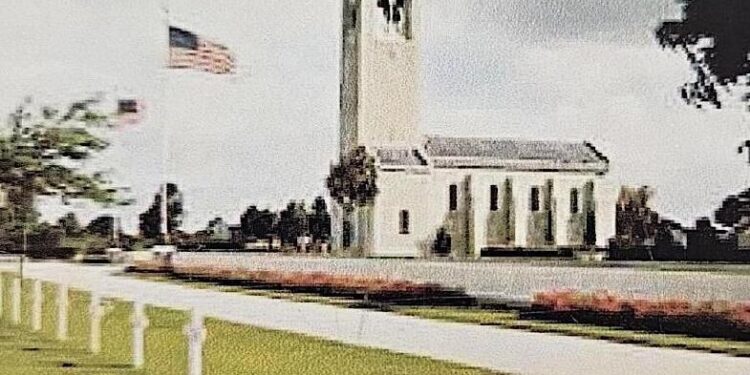Veterans Day is a reminder of those who serve their country. For Barbara Moeller, it’s also a reminder of an uncle who made the ultimate sacrifice in World War II to help free France from Nazi Germany’s grip.
And, it’s a reminder of what the family didn’t have confirmed until 2005, after believing for more than 60 years that he and his crewmates died when their badly-damaged bomber crashed into the English Channel.
Ernie J. “Jim” Dickenson was brother to Moeller’s mother, the fourth of 12 children. Born and reared outside of Duke in western Jackson County, Jim Dickenson was a rural youth who enlisted in the U.S. Army right out of high school in 1941. Initially trained as an airplane mechanic, Dickenson resigned in November 1942 to accept a commission and begin training as a pilot. Flight Officer Dickenson ultimately became part of the 96th Bombardment Group, assigned to England’s staging areas for Allied military personnel battling Germany.
The details of what happened to the B-17 flight crew of 1st Lt. Jack McMath were murky for years. What Dickenson’s family knew was this: He and six of his crewmates died when their B-17 crashed (three crew members were able to parachute from the plane and survived the war, after being captured and held as POWs). Moeller said her family believed for decades the bomber plunged into the English Channel while trying to get back to base, and that’s where his remains lay.
In 2005, due to the tenacity of Frenchman Jean-Paul Favrais, who as a child remembered seeing an American aircraft crash near his home, investigation by two determined family members, and accounts from two of the three surviving crew members, the family learned Dickenson’s plane actually crashed in France and villagers took care of the bodies.
“That’s the only reason we know what happened to him,” Moeller said.
Family notes on a translated story run in a French newspaper noted “61 years later we learned that he did not fly his battle-crippled plane into the English Channel after a bombing run over Rennes, France. The plane actually hit an electrical wire and exploded as they were going down near Clayes, France.”
“At least mother finally learned what happened to her brother….”
Dickenson’s niece Margaret Beck spent years doing research, trying to find out what happened to her uncle and tracking down family members of his crew.
In notes made to the family in July 1997, Beck described her attempts to obtain her uncle’s service records from the National Personnel Center in St. Louis, which came to an abrupt end in 1985 after learning many World War II records there were lost in a 1973 fire. The search might have ended, but for the discovery by Dickenson’s youngest sister Joyce in the mid-1990s that his name was on the Wall of the Missing in the American Military Cemetery in Brittany, St. James, France. That’s when Beck began her research.
Pieces began to come together.
Beck’s search led to Staff Sgt. Arthur Shilo, the bomber’s ball turret gunner.
Shilo’s story: the bomber was one of 10 in a formation on a mission to bomb the naval storage warehouse complex in Rennes, France. Shilo said when they reached their target, “flak was very intense and their left engine was damaged and quit. That caused them to drop out of formation and lose altitude rapidly, but McMath was able to catch up and bring his plane back into position for a time.” Shilo said fighter planes “picked on them,” causing more damage. The bomber gradually faded from the formation and was last seen about 5:45 p.m., going down. Shilo, in the ball turret, jumped because his badly-damaged area was losing oxygen. He blacked out and doesn’t know what happened afterward.
A December 2003 paper by Favrais shed further light on the plane’s final moments, noting that “according to the witnesses I met, the B-17 plane had two engines on fire, maybe three. It seemed to try an emergency landing, but when it was about eight or ten meters from the ground, it hit a high-tension line, violently exploded and was completely pulverized.”
Tail gunner Staff Sgt. Harry Boegaholz wrote in a June 1947 account that he believed his bomber “was heading toward the English Channel, as he could see the coast when he jumped….A Frenchman told him at Rennes, France, that the plane blew up in the sky, but he was not sure if it was his plane.”
The military initially said that based on the altitude, the fact no parachutes were observed, and the fact the bomber didn’t return to base, it was presumed to have crashed into the English Channel. That version persisted for years, even though an investigation into the crash in the early 1950s indicated some parts of the bomber had been found in France. Beck said Dickenson’s sisters remembered their mother received letters after the war, telling her something about parts of a plane being found, but “she threw the communications way and didn’t speak of them again.”
The full details came to light when a May 2004 ceremony in Clayes, France lauded seven men who died when a bomber crashed near the town on May 29, 1943. But, it wasn’t until June 2005 that Dickenson’s family learned the full details, after Favrais continued his mission to track down family members of those men. A monument holds their names, including Lt. Ernie J. Dickenson, the co-pilot.
In a family email in July 2005, Beck noted “After 62 years, we now know what happened to my mother’s brother Ernie Jim Dickenson, after he went missing on a bombing raid over Rennes, France, during WWII.”
Want to reach a local audience and grow your business?
Our website is the perfect platform to connect with engaged readers in your local area.
Whether you're looking for banner ads, sponsored content, or custom promotions, we can tailor a package to meet your needs.
Contact us today to learn more about advertising opportunities!
CONTACT US NOW




